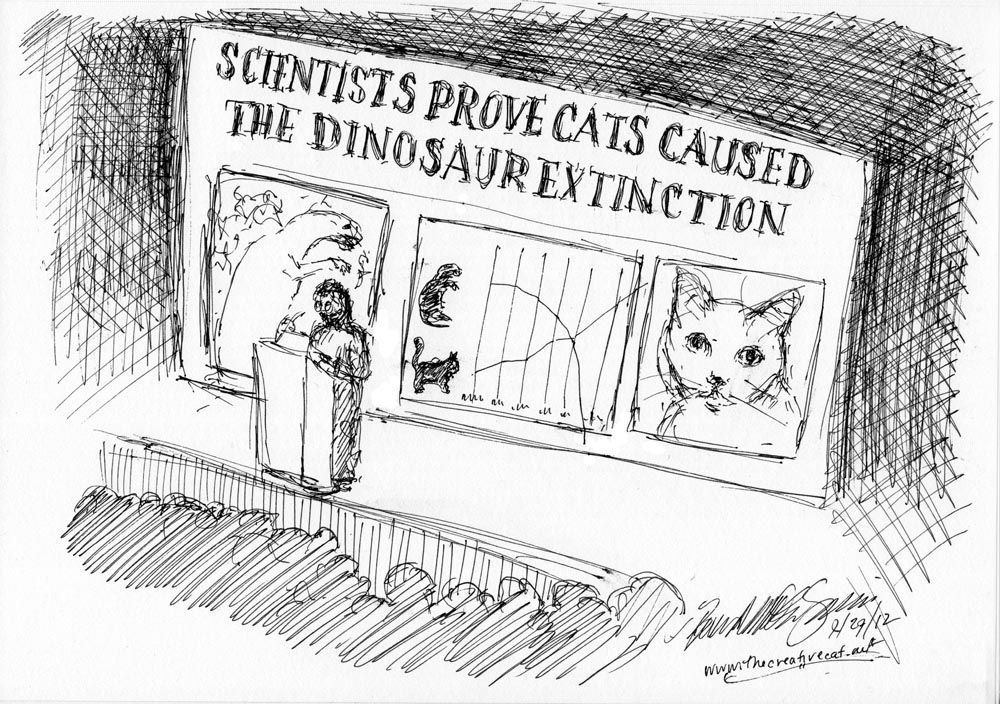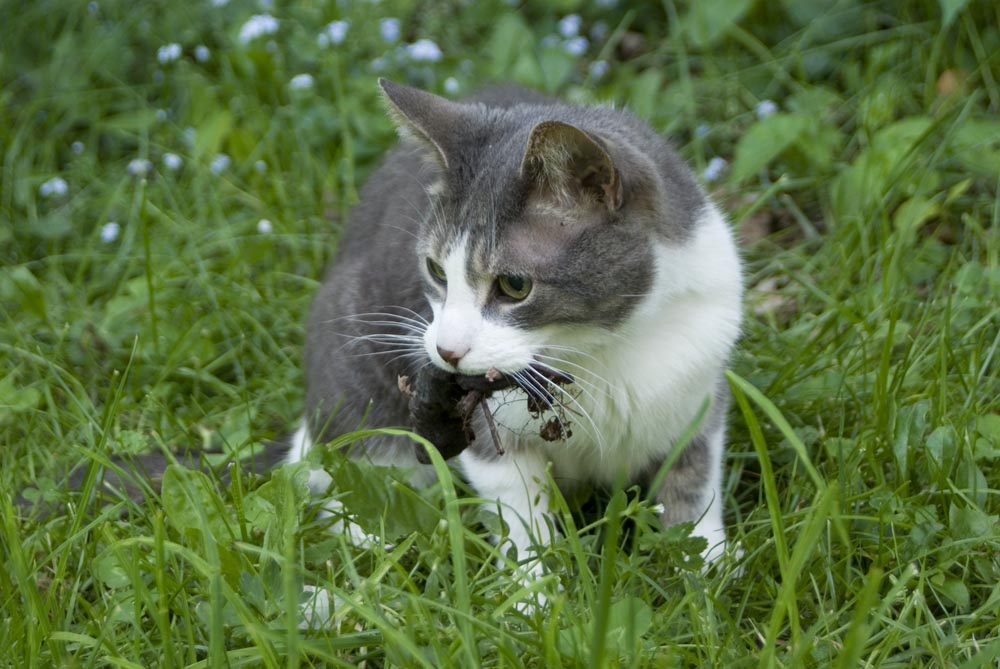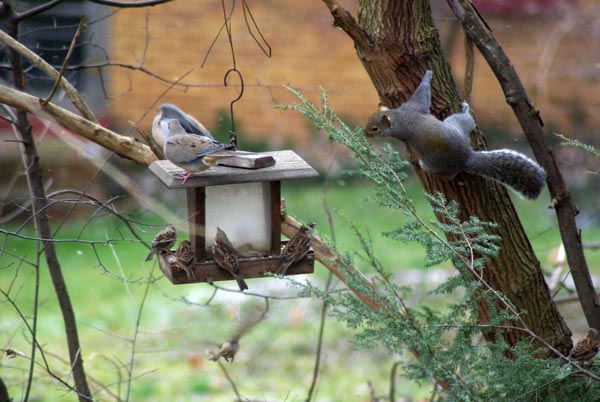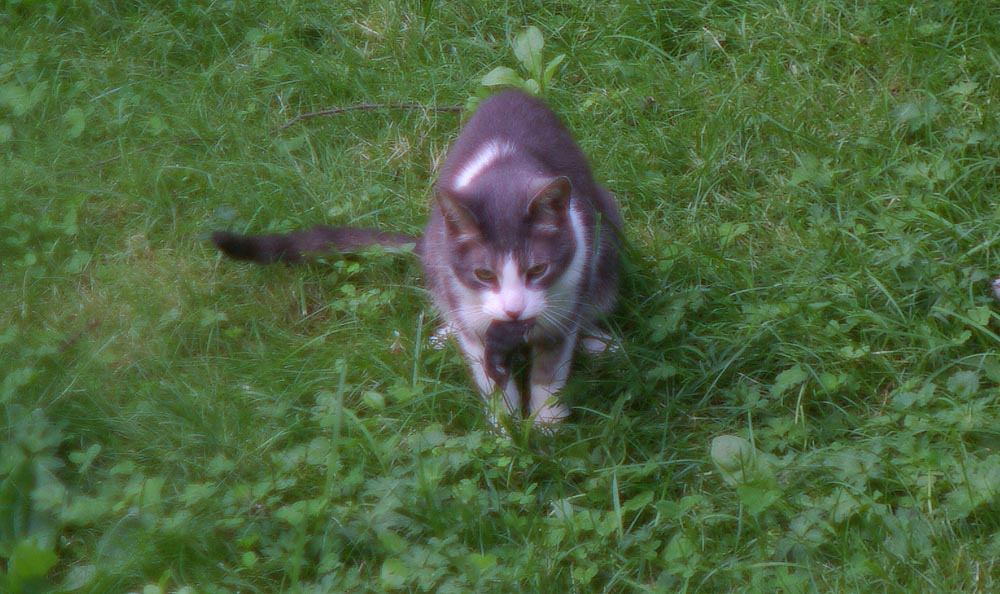Scientists Prove That Feral Cats Killed the Dinosaurs

No, not really, I just though I’d beat them to the punch. Stray and feral cats have been blamed for so many other problems that changed life on earth for humans, like giving you toxoplasmosis gondii, spreading rabies and causing songbirds extinction—why not the dinosaurs too?
At one point they were also credited with keeping Europeans from getting the bubonic plague because of the “coincidental” evidence that the killing of possibly millions of cats because they were devils took away the rodent protection from Middle Age food stores, enabling the rats to overpopulate. But it’s not even possibly true—the plague killed as many humans in areas where cats weren’t being killed for religious reasons and even the commonly accepted rat flea-bubonic plague popular science is questionable, though we commonly accept both stories, the same way people readily report and accept that cats are depleting populations of songbirds because it seems to make sense and it makes a good shocking headline.
Despite evidence to the contrary even in the studies they cite, headlines lately have been reporting that cats spread t. gondii to humans though it’s most often spread through unwashed vegetables and undercooked meat. They’ve also spread the word that feral cats leave human populations at risk for rabies, even though most rabies cases are reported in wildlife who don’t necessarily live in the wild but in our own back yards, and are usually the ones spreading the disease to cats. This would be simply an annoyance if it wasn’t actually putting cats and humans at risk with misinformation—cats at risk of homelessness and even death from disease, neglect and abuse and humans at risk of infection and even death from preventable diseases.
If you question these headlines as well, I have links to articles and actions you can take.

I’ve never seen a cat kill a bird, therefore cats don’t kill birds.
Some of my cats join me in the yard and plenty of neighbor cats have also spent time out there. I’ve watched dozens cats for years and never seen one kill a bird, therefore cats don’t kill birds! Isn’t that good news?
Not only that, but I have seen birds kill birds! Each winter another juvenile Cooper’s hawk kills at least one mourning dove or cardinal or sparrow each day, and I’ve also watched crows and blue jays trash chickadee and cardinal nests, throwing eggs to the ground and beheading and tossing fragile nestlings all over the yard. Aha! Birds kill birds! Now that’s news!
Of course I’m kidding with my conclusions but not with my observations, in all my years of observing cats and birds I’ve seen cats chase birds but never even come near catching one, and I regularly see birds killing other birds as I described, all in my own back yard. Birds are darned difficult for cats to catch, and ecologically speaking, a waste of energy for cats when there’s literally easy pickings running all around them.
However, extrapolating from my observations that cats don’t kill birds but that birds do kill birds is about as accurate as some of the extrapolations others have made from scientific studies of cats interacting with wildlife using very limited populations and brief time over small physical areas that cats are not only killing millions of songbirds, but are effectively responsible for the extinction of certain species. Blaming cats for killing millions of birds, and writing sensational headlines about it even when the article proves otherwise hits pretty close to home for me.
I am not a scientist, and I do know that cats kill birds and many other things as well. In addition to being a Master Gardener and managing and teaching about Backyard Wildlife Habitats, I led a birding group and hosted hikes and walks for several years to find and teach people to identify species of birds and their habitats and songs, and how to photograph birds in the field. I have counted the bird populations at the nine feeders in my own Backyard Wildlife Habitat for the 22 years I’ve been in this house, where I have also taken cats outdoors with me, and observed the activities of the neighbors’ cats and strays and ferals for the same amount of time.
Professionally, I have for over a decade worked with a number of small and large local conservation organizations, writing literature, designing and illustrating publications and signs, photographing conservation areas for use in these materials and for my own pleasure. For fun, I visit local trails and natural areas and friends’ farms and property with my camera and art materials finding the details and the panoramas of my world in these places. I am deeply involved on many levels in what is happening in my environment.

My bird populations have remained pretty steady through the years, adding a few species like the Baltimore Oriole family who call my wild black cherry tree home, and the wood thrush who whistles from the trees out back. The neighborhood cats who always visited my yard for its reputation as a great hunting spot have nearly vanished in populations, partly my own efforts at rescuing and rehoming the strays who were amenable to it and getting any cat who was not owned by someone spayed or neutered and socializing the kittens, hopefully for adoption. In my little corner of the world, trap-neuter-return, or TNR, has worked as planned, and along with more neighbors keeping their cats inside, outdoor cat populations are down to about five right now, while bird populations have not changed.
The KittyCam Study
After a series of prior articles implicating cats for reducing bird populations, even using headlines with the word “killer” and “slaughter” in them, the articles about the most recent “KittyCam” study threw fat on the fire when they should have thrown water on the fire and pretty much put it out. The study was to analyze both hunting and risk behaviors in outdoor cats. Most previous studies had only observed what outdoor cats brought home and extrapolated from those numbers but had no idea what they did when away from home. This study actually attached a little video camera on a cat’s collar to record the cats’ activities pretty much from a cat’s eye view. Owners downloaded the video daily to submit to the study. Can’t go wrong, right?
The moderator of the study herself, graduate student Kerrie Anne Loyd, said in an interview that she was surprised at the findings, but not because the cats turned out to be such cold-blooded killers, shredding birds wherever they went. Fifty-five cats collected over 2,000 hours of video, showing that fewer than half of them actually hunted with a total of 39 successful hunts among the cats, most of which involved small lizards and snakes followed by small mammals but also included worms and butterflies, but only five of the successful hunts were birds.
“Cats aren’t as bad as the biologists thought,” said Ph.D student Kerrie Anne Loyd.
Loyd is with the Wildlife Ecology and Management at the Warnell School of Forestry and Natural Resources.
The researchers worked under UGA professor Sonia Hernandez, documenting the cats during all four seasons.
Common household cats were required to wear the cameras for seven to 10 days when their owners let them out of the house.
During their research, researchers reviewed more than 2,000 hours of footage. They determined that the cats “did not hunt as much as we thought,” according to Loyd.
“About 44 percent of cats engaged in predatory behavior. We found in suburban areas, they are catching small lizards and small snakes, so that was surprising. They were also eating worms and catching butterflies, things they would never bring home. So without this camera, we’d have no idea what they were doing,” said Loyd.
From “Kitty Cameras Show Athens Cats on the Prowl“, on CBS Atlanta.
(Here is a link to the study, “An Evaluation of Feral Cat Management Options Using a Decision Analysis Network” and here is a link to the website for the study The National Geographic & University of Georgia Kitty Cams (Crittercam)Project.)
This does not sound like a bloodbath to me, nor activity that endangers any species of birds—and I also think it’s a very small sample, too small to extrapolate larger numbers from and choose a plan of action against cats, yet the American Bird Conservancy reported that bird kills constituted 13% of all the kills in the study, an accurate figure but which sounds like far more than five birds and went on from there.
“If we extrapolate the results of this study across the country and include feral cats, we find that cats are likely killing more than 4 billion animals per year, including at least 500 million birds. Cat predation is one of the reasons why one in three American bird species are in decline,” said Dr. George Fenwick, President of American Bird Conservancy, the only organization exclusively conserving birds throughout the Americas.
“I think it will be impossible to deny the ongoing slaughter of wildlife by outdoor cats given the videotape documentation and the scientific credibility that this study brings,” said Michael Hutchins, Executive Director/CEO of The Wildlife Society, the leading organization for wildlife professionals in the United States. “There is a huge environmental price that we are paying every single day that we turn our backs on our native wildlife in favor of protecting non-native predatory cats at all cost while ignoring the inconvenient truth about the mortality they inflict.”
From ““KittyCam” Reveals High Levels of Wildlife Being Killed by Outdoor Cats” published by American Bird Conservancy, a press release that was widely republished by news media under various titles.
Fenwick’s addition to “include feral cats” is something to note here in what amounts to his total kills—how many feral cats is he counting? He doesn’t say, and no one really knows how many homeless cats live entirely on their own in this country; I’ve seen figures from 60 million to 200 million, but no real study has been done, we really don’t know. Nor do we know what they do. Yet his own organization’s 2009 report on threats to migratory birds more or less refutes this as cats rate a single paragraph on page 11 after several pages about the greatest known threats to habitat made by humans, giving an inaccurate figure of 90 million pet cats and an equally inaccurate statement that “the majority of these roam outside at least part of the time”, saying only, “Cat predation is an added stress to wildlife populations already struggling to survive habitat loss, pesticides, and other human impacts.”
And a New York Times writer didn’t seen to agree with Fenwick and Hutchins in “Kitty Cam Shows Not All Cats are Killers, nor Mother Nature Network in Cats may not be as significant of a threat to songbirds as thought.
And remember, this is a study by a graduate student and hasn’t yet been published.
But successful trap-neuter-return (TNR) efforts in some cities have been questioned and even lost funding through statements like ABC’s even prior to this study, and legislation to allow shooting feral cats nearly passed in other communities, in part based on or using evidence like these statements. We need to study both the needs and the impact of all cats and especially feral cats in much greater depth, not make guesses and publish them with the hot button phrase “ongoing slaughter of wildlife”, putting cats in the same class as baby seal clubbers and elephant ivory poachers. We especially don’t need to manipulate the facts to suit our purposes and put anyone in danger—not homeless cats, not imperiled bird species or other wildlife, and not human beings.

One last observation
There have always been outdoor cats, and there have always been wild birds. We didn’t regularly spay and neuter our cats until the 1960s when safe use of anesthetic for small animals was established, and even after that cats often weren’t spayed and neutered until six months or a year old, often after a litter or more of kittens was born; then since the early 1990s pediatric spay and neuter has become more popular, all in the name of reducing the numbers of unwanted pets.
Do we know if the population of outdoor or unowned cats is smaller today than it was then as a result of this? I have not found a single study to compare, and I wish we knew the figures from 50 years ago to contrast with today. But if the trend over the past 50 years is for more cats to be spayed and neutered, and the surgery done at a younger age all the time, and more people have been keeping their cats inside all the time with each passing decade, and TNR programs have been reducing the populations of cat colonies by spaying and neutering and removing kittens where possible, then outdoor cat populations have to be declining as well—unless I’m just unfairly extrapolating. If bird species have been declining over the same period, I wonder that cats have truly had any more effect on bird populations today than they ever did through history.
Take action
Sign a petition through Alley Cat Allies to tell the media to engage in more responsible reporting on behalf of homeless cats.
Read and sign a petition, ABC News Producers and Reporters: Tell ABC News to present all of the facts about free roaming cats, in response to the 20/20 program entitled “Kitty Cam Killers”.
Learn about stray and feral cats through Alley Cat Allies and Alley Cat Rescue.
Read Vox Felina to learn more about stray and feral cats and information and background on articles about stray and feral cats in the news.
All images used on this site are copyrighted to Bernadette E. Kazmarski unless otherwise noted and may not be used without my written permission. Please ask if you are interested in using one in a print or internet publication. If you are interested in purchasing a print of this image or a product including this image, check my Etsy shop or Fine Art America profile to see if I have it available already. If you don’t find it there, visit Ordering Custom Artwork for more information on a custom greeting card, print or other item.


Pingback: The Creative Cat - It’s All the Fault of Those Pesky Humans
Pingback: Community Impact Award | Animal Alliance of Greater Syracuse
I really enjoyed your article…very informative…gets me to thinking…cats kill birds, butterflies and voles, dogs kill cats and birds, people kill, well,… EVERYTHING…..water, air, soil, cats, dogs, other people, lions, tigers, bears, buffalo, elephants, gorillas, birds, snakes,…gosh, you name it and people have killed it. Some deliberately, some incidentally, some ignorantly, some necessarily, but the carnage is there….so who are we to judge what a cat does in his spare time? Hooray for kitty cats!
Carol, I agree! It’s part of life on earth, and while trying to influence things when a species is in danger is not a bad thing, it only works if you really identify what the problem is, and in this one, cats are not the problem.
Hmmm… 25 years ago, I killed a bird with my car. Since I’d never had a Honda before, clearly Japanese cars have contributed to the avian decline. I mean, charcoal grey Japanese cars. Junk science – it’s not just for breakfast any more.
But in all seriousness, another flaw in the kitty cam study is that it focused (pun intended) on house cats. Clearly, a cat catching butterflies and worms is hunting for sport – because she can, she has a regular food supply and hunting is just play. She can waste her time with things that flutter and are a challenge. (And even then, as you pointed out, Bernadette – FIVE birds.) A hungry unowned cat, unsure of where her next meal is coming from – does not have time to waste on such nonsense, especially not when a far easier source of food is on the ground. I’m sure if they put cameras on feral cats (now *there’s* a fun job for which I will not be volunteering) they’d see a disproportionate amount of rodents, and the occasional bird. Yes, I made that up, but if they can draw unsupported conclusions, so can I. Great article. PS – were there any dinos the size of mice?
Harry, that was another flaw in the study, using only housecats to extrapolate to all cats. The feral cat study would not be as easy but would not be impossible–I already know several dozen people who observe stray and feral colonies and would be glad to also watch what they catch for the sake of their safety. Many stray feral cats are fed daily so while they do live outdoors they still have the luxury of play, and that’s all the more reason to support stray and feral colonies.
And we may laugh about our cats lazing around all day, but just like not making the physical effort to catch a bird it’s evolutionarily sound behavior, they are small, solitary creatures, and expending the energy gained from a meal to catch it is unproductive. Their energy is really better spent only on the minimum amount needed to catch dinner.
And I hope you got rid of that killer Honda.
Bernadette,
Great article, thoroughly discussing the topic!
I remember when I was a kid back in the ’60s when the media started talking about FeLV (Feline Leukemia). It set off a panic too. My mom immediately got rid of all our cats because she was afraid we would catch Leukemia from them. My mom, a nurse, bought into that most ridiculous idea just as people today are willing to do the same about T. gondi and the ABC bird issues. People, people, people………wake up and ask for facts before believing everything you read or see.
Thanks Bernadette for bringing this out.
Andrea, I remember people thought they could get leukemia from cats! Sometimes people come to these conclusions on their own, but sometimes it’s fanned by media as well, and I can’t figure out why a good headline with no real story always works.
Thinking of you with Mewdy Blue, and hope you have a good day.
VERY very well said. Thanks for publishing this. And we LOVED your faux headline!
Lisa, thanks for reaading–I know it’s pretty long, but I’ve been trying to find the time to get it all out there. And the headline was an important part of it!
Great post Bernadette! I expect ABC to now issue a press release saying “Feral Cats Killed the Dinosaurs” and the mass media to pick it up. Get ready for your 15 minutes of fame!
Vicki, I’m ready, just as long as they give me credit for my research!
My dog killed a bird once. Perhaps dogs are responsible for the reduction in bird populations. All kidding aside, this was a very informative article. I remember seeing something on the news once about the cat killers. But I never gave it much thought other than to roll my eyes at the media for their pathetic attempt to make “news” out of nothing.
Dawn, you’re right on the mark, perhaps dogs should be implicated! People really are getting carried away with this whole issue and it’s actually beginning to affect the way cats are treated in society. Wish more people would roll their eyes and ignore like you.